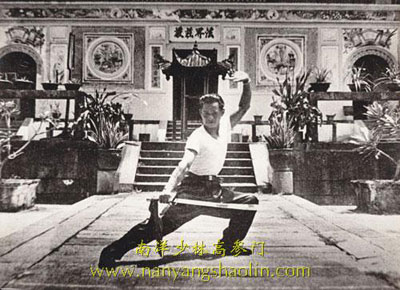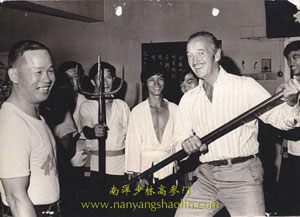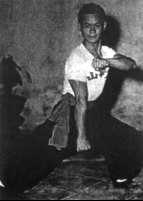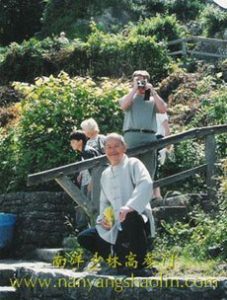 Quek Heng Choon was born in 1926 in Huian county in the Fujian province of China. At the age of 13, he met a wandering medicine seller named Liu Pingshan who was a master of the Taizu style and became his student for three years.
Quek Heng Choon was born in 1926 in Huian county in the Fujian province of China. At the age of 13, he met a wandering medicine seller named Liu Pingshan who was a master of the Taizu style and became his student for three years.
In 1942, aged 16, his uncle asked him to join the army. He refused and left home to live in the Quanzhou Kaiyuan Temple. There, he studied martial arts under Monk Maoyue for 15 months learning Wuzu Quan Sanzhan Simen Quan 18 step Saozhuan Quan.
After this period he left the temple but realised that if he returned home, he would again be asked to join the army so he went to Xiamen to work in a teahouse before eventually deciding to move to Singapore to live with his aunt. In 1947 Quek Heng Choon went to Singapore aged 21 where he heard that it was possible to study martial arts in the Singapore Shuang Lin Temple where Seh Koh San was abbot at the time. He was eventually accepted as a student.
 Seh Koh San was very strict with his students and insisted they remained inside the temple walls to study martial arts for at least three years, during which time they weren’t allowed to step outside the temple gates. Training took place three times a day, at five in the morning, at midday, and at seven in the evening, every single day.
Seh Koh San was very strict with his students and insisted they remained inside the temple walls to study martial arts for at least three years, during which time they weren’t allowed to step outside the temple gates. Training took place three times a day, at five in the morning, at midday, and at seven in the evening, every single day.
After seven years of dedicated training Seh Koh San informed Quek Heng Choon that his study of the arts had been successful, and that he could now ‘come down from the mountain’ (leave the temple).
In 1954, he left the temple with a classmate and together they started the Singapore Sao Hua San Athletic Association.
 In 1956 he left for Penang where he founded the Penang Sao Lim Athletic Association for Seh Koh San. He spent two years setting up the school and finding new students for his teacher – at one time there were more than 300 people studying there. The school is now run by Master P’ng Chye Khim.
In 1956 he left for Penang where he founded the Penang Sao Lim Athletic Association for Seh Koh San. He spent two years setting up the school and finding new students for his teacher – at one time there were more than 300 people studying there. The school is now run by Master P’ng Chye Khim.
In 1958 he founded another school, Penang Sao Wah San Athletic Association, and later, taught at another school in Penang. The following year he went to Kuala Lumpur to work in the harbour and teach martial arts in a new village near the harbour, three times a day.
On May 16th 1960 his teacher Seh Koh San passed away. At this point Quek Heng Choon started to teach students on his own in order to popularise the martial arts. In 1963 he was asked to become the chief instructor of a school in Kuala Lumpur and became famous for demonstrating Ying Qigong (hard chi gung[e3] ) by breaking marble table tops on his back and with his hand. He even received praise from the prime minister of Singapore, Lee Kuan Yew (Li Guangyao).
In 1971 he started his first formal school, Quek Heng Choon Martial Arts Sport School, which attracted students from both Singapore and Malaysia. The next year he was to be the permanent chief instructor of Penang Shao Ci Shan Athletic Association. He represents the original 50th generation of Shaolin.
 In 1973 his students joined the first South-East Asia Competition and were very successful. He was made an advisor and judge for the competition. In the same year, a Hollywood movie company shot the movie ‘Paper Tiger’ in Malaysia and asked Master Quek to create some of the fight scenes along with Master Leow and Master Lai. Some of his students also acted in the movie.
In 1973 his students joined the first South-East Asia Competition and were very successful. He was made an advisor and judge for the competition. In the same year, a Hollywood movie company shot the movie ‘Paper Tiger’ in Malaysia and asked Master Quek to create some of the fight scenes along with Master Leow and Master Lai. Some of his students also acted in the movie.
In 1974 he went back to China to visit his family and also visited the Quanzhou Kaiyuan Temple, where he had studied martial arts 30 years before. In 1977 he initiated the Kuala Lumpur Song Shan Shaolin Wushu Association and became a permanent chief instructor of the school. In 1990 he started the Shaolin Gao Can Mun in Singapore of Heroufo State and became the chief instructor.

In 1993 he went back to China (Fujian Quanzhou) and started a school to teach Shaolin Wushu and Yijining.
In 1998, he returned to Malaysia to teach his students again, which he did until his demise. He taught Yangshen Shu, long and short weapons, Yijinjing, Luohan Yangshen gong, Shenxinfa, Quantao: Yizhimei, Yizhichun and much more.
Master Quek is considered to be Shi Gao Can’s most important and influential student from the Singapore/Malaysia era. He is also infamous for his fight with Sek Koh Sam!
 Unfortunately during a visit to China in February 2010 Master Quek succumbed to illness and passed away. He was aged 85.
Unfortunately during a visit to China in February 2010 Master Quek succumbed to illness and passed away. He was aged 85.


 Nick Hurst, author of “Sugong”, a book about Grandmaster Quek Heng Choon’s life story.
Nick Hurst, author of “Sugong”, a book about Grandmaster Quek Heng Choon’s life story.
Quek Heng Choon –> Lai Khee Choong 黎鉅忠

Shaolin Nam Pai Chuan
The style was brought to international attention by Christopher Lai Khee Choong. Prior to Lai’s travels to Europe, he studied Shaolin Kung Fu under Quek Heng Choon from 1967 onwards. At that time, Lai also practiced Taekwondo under Leow Cheng Koon, who was the head of the Malaysian Taekwondo Federation. Later, Lai would serve as Secretary General of Malaysian Taekwondo Association (WT) from 1974 until him leaving the country in 1979.[2][additional citation(s) needed]
Lai had emigrated to United Kingdom around 1977 and opening his martial arts school in 1979 at London. Under permission by Sifu Quek, Lai used the name “Shaolin Nam Pai Chuan” for his martial arts system, that combined Lai’s expertise in Northern and Southern Shaolin Kung Fu, Taekwondo and other styles – such as Judo and Wado-Ryu Karate.[1] The style has since expanded to include many centres on the UK and other countries.
During a training visit to London in 2009 Master Quek named Christopher Lai Khee Choong, who is head of Nam Pai Chuan worldwide, as his successor and asked that the school be renamed as “Shaolin Gao Can Mun Nam Pai Chuan”.
Quek Heng Choon –> Lai Khee Choong –> Gary O’Sullivan
Nanyang Shaolin Special Interview 2010 Jan











